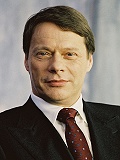BASF
Concentration on higher-end plastics / Growth rates above the market / Polycarbonate of interest
 Dr. John Feldmann (Photo: BASF) |
BASF (Ludwigshafen / Germany; www.basf.com) will continue to shift its plastics activities towards the higher value-added end, according to managing board member John Feldmann. Speaking at a press conference in advance of K 2007, he said the world's largest chemical producer intends to increase the share of innovative products and specialities in its portfolio from around 25% currently to 40% by 2010, mainly through partnerships with its customers.
Feldmann named the automotive and building insulation sectors as two in which innovative plastics can play a leading role. Here, in particular, he said BASF can use its "superior technology" to develop products that do not have to compete via price with those of producers in countries with access to cheap raw materials.
Although BASF's high end portfolio is already broad, the executive, who has board-level responsibility for plastics, said there are gaps that could be filled through bolt-on acquisitions or cooperation projects with other players. BASF would like to have access to polycarbonate for automotive glazing applications, Feldmann told PIE. However, he said management is not prepared to pay an exorbitant price for such a business. BASF did not bid for GE Plastics.
Due to the different requirements of its high-end portfolio compared with its more commodity-oriented product lines, BASF now employs three different business models. The first category, "lean, reliable basic supplier", includes styrenics and some polyamides, along with base PU products. The "product/process innovator" and "customised solutions provider" categories are dominated by engineering polymers and PU systems houses. Because energy-efficient products will see increasing demand as the world starts to cope with climate change, BASF is expanding capacity for its new EPS insulation foam "Neopor", which Feldmann said needs less material to meet the same performance requirements as the traditional "Styropor" foam – see Plasteurope.com of 29.03.2007.
In its growth drive, Feldmann said, BASF will "increasingly concentrate" on fields offering "adequate potential for differentiation in the market," where it can offer customers "a clear advantage." Altogether, its target for plastics is to continue to expanding at 2% or more above annual market growth. Many of the group's products already are growing at much higher rates, he said. BASF sees global demand for plastics increasing at an annual rate of about 5% up to 2015, with the strongest growth in Asia.
Feldmann named the automotive and building insulation sectors as two in which innovative plastics can play a leading role. Here, in particular, he said BASF can use its "superior technology" to develop products that do not have to compete via price with those of producers in countries with access to cheap raw materials.
Although BASF's high end portfolio is already broad, the executive, who has board-level responsibility for plastics, said there are gaps that could be filled through bolt-on acquisitions or cooperation projects with other players. BASF would like to have access to polycarbonate for automotive glazing applications, Feldmann told PIE. However, he said management is not prepared to pay an exorbitant price for such a business. BASF did not bid for GE Plastics.
Due to the different requirements of its high-end portfolio compared with its more commodity-oriented product lines, BASF now employs three different business models. The first category, "lean, reliable basic supplier", includes styrenics and some polyamides, along with base PU products. The "product/process innovator" and "customised solutions provider" categories are dominated by engineering polymers and PU systems houses. Because energy-efficient products will see increasing demand as the world starts to cope with climate change, BASF is expanding capacity for its new EPS insulation foam "Neopor", which Feldmann said needs less material to meet the same performance requirements as the traditional "Styropor" foam – see Plasteurope.com of 29.03.2007.
In its growth drive, Feldmann said, BASF will "increasingly concentrate" on fields offering "adequate potential for differentiation in the market," where it can offer customers "a clear advantage." Altogether, its target for plastics is to continue to expanding at 2% or more above annual market growth. Many of the group's products already are growing at much higher rates, he said. BASF sees global demand for plastics increasing at an annual rate of about 5% up to 2015, with the strongest growth in Asia.
10.07.2007 Plasteurope.com [208494]
Published on 10.07.2007

 German version of this article...
German version of this article...